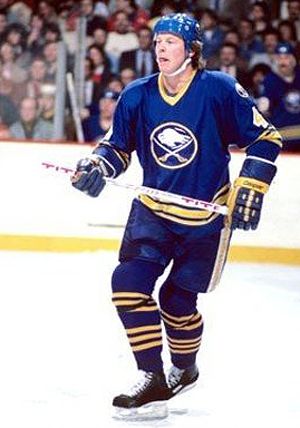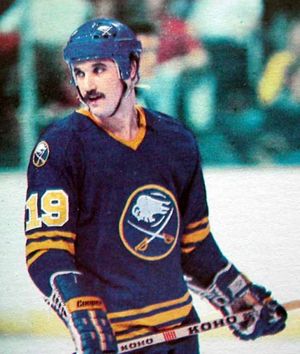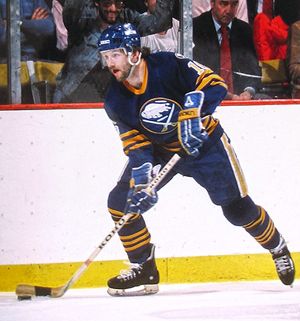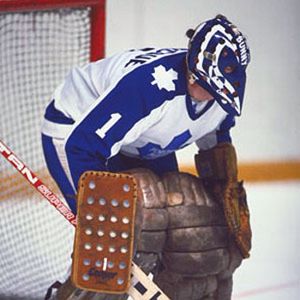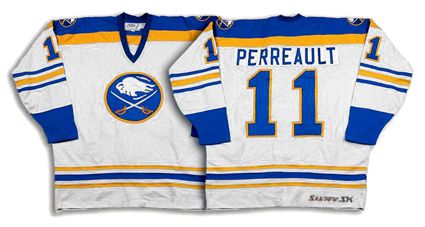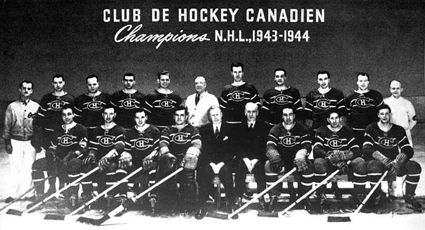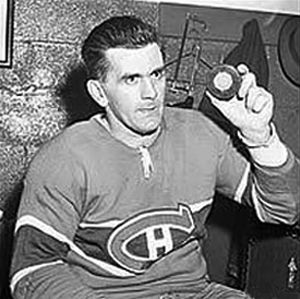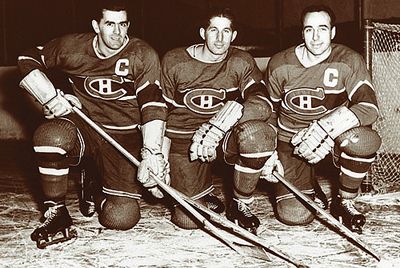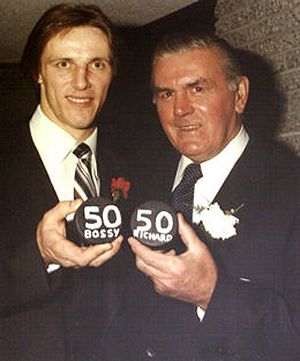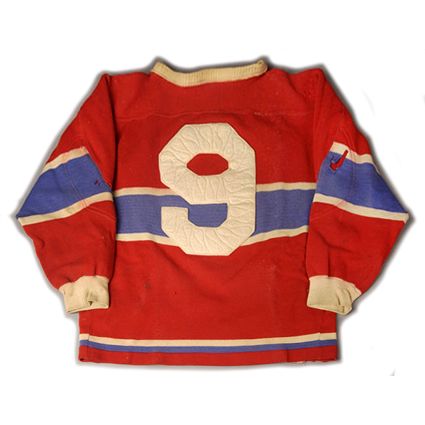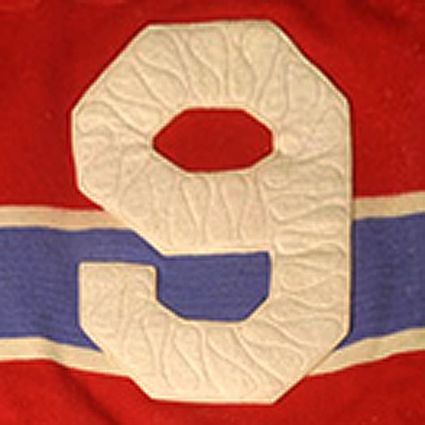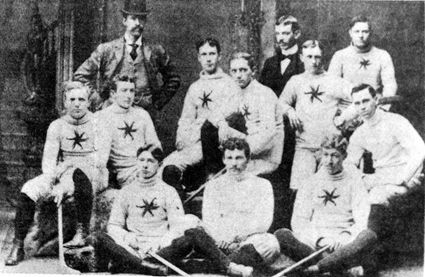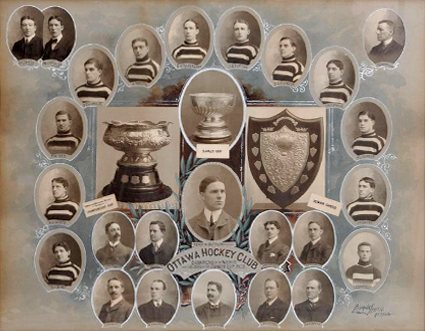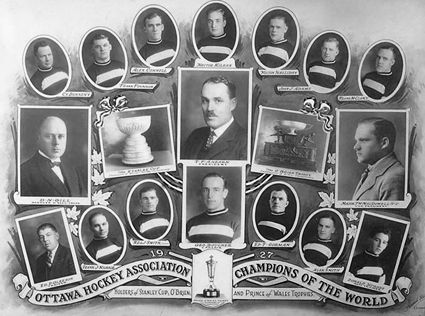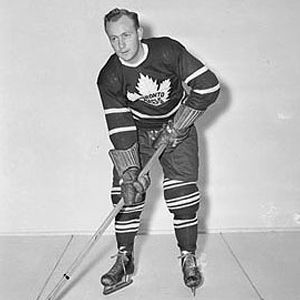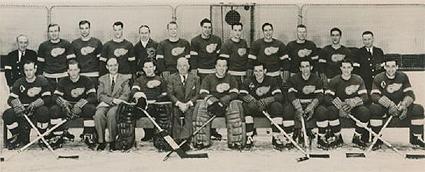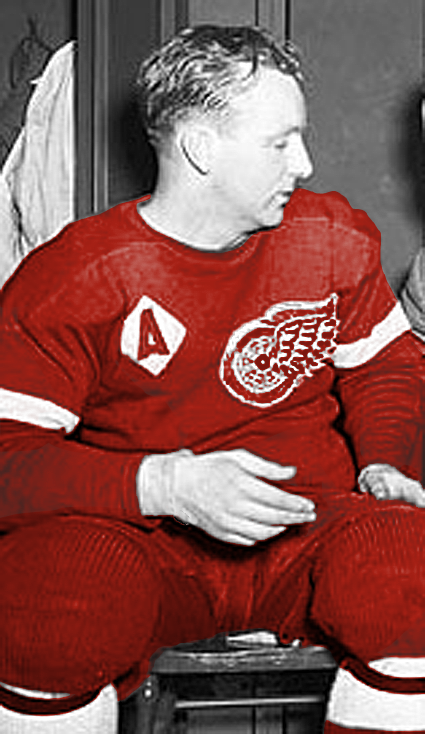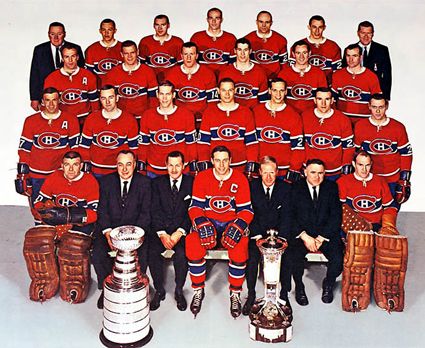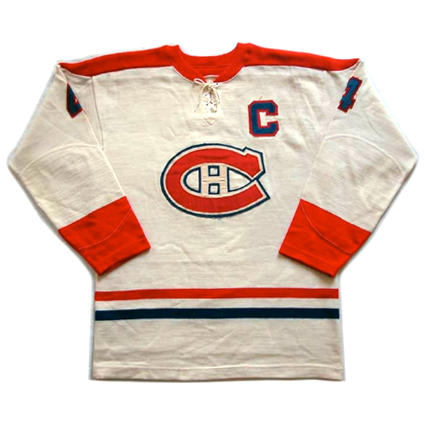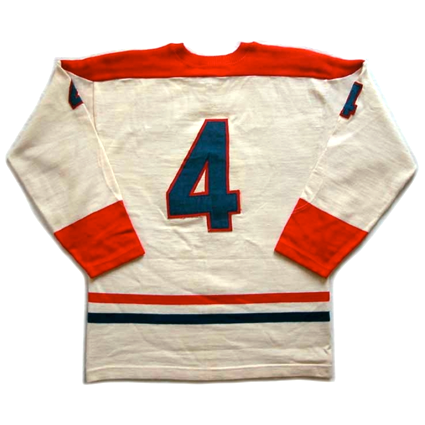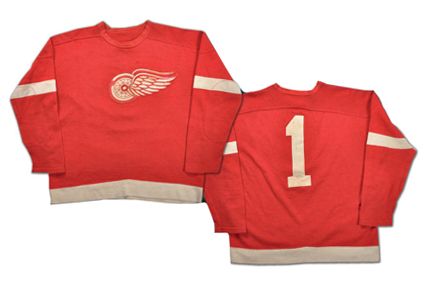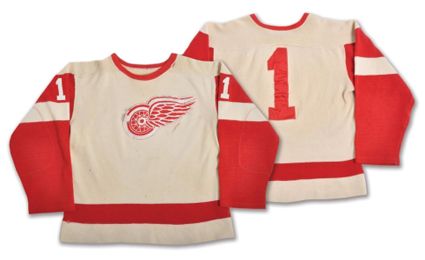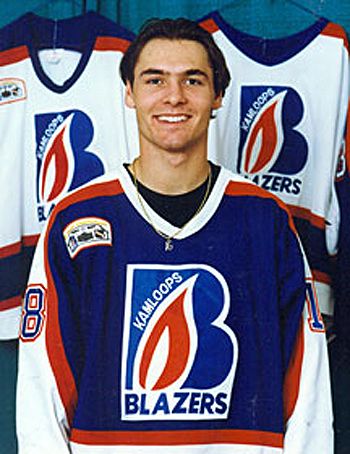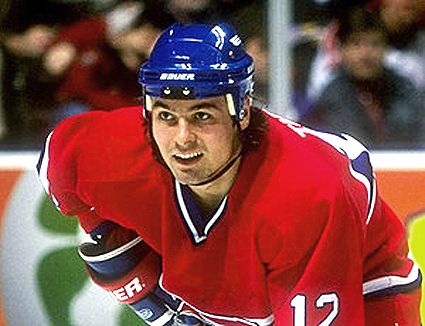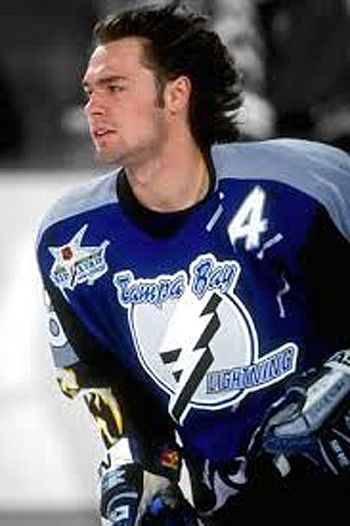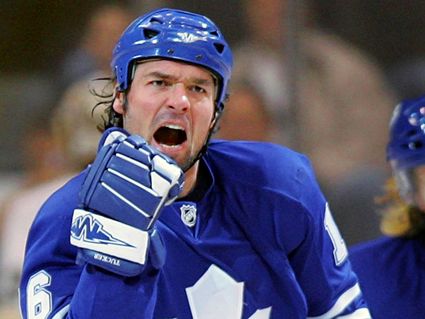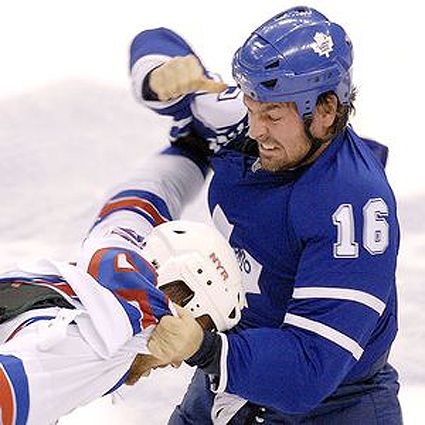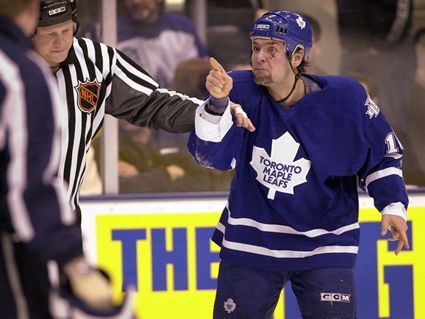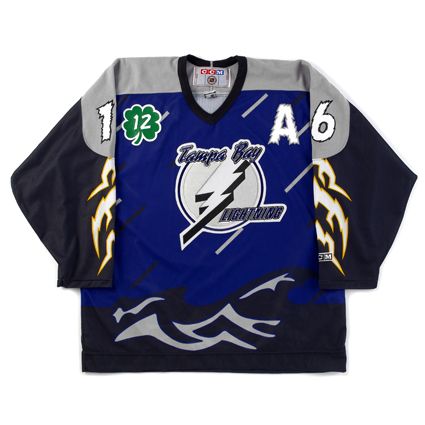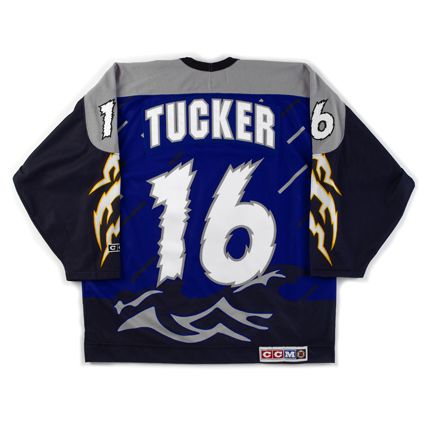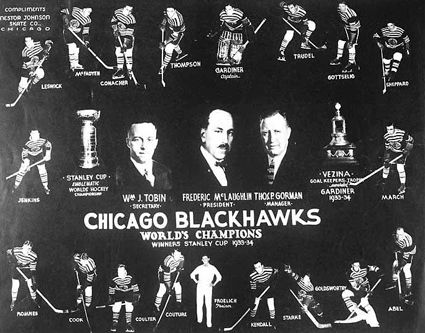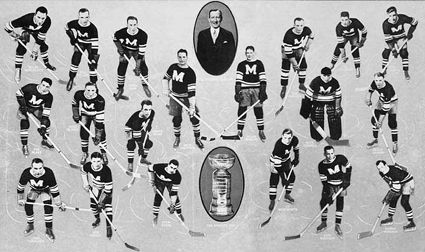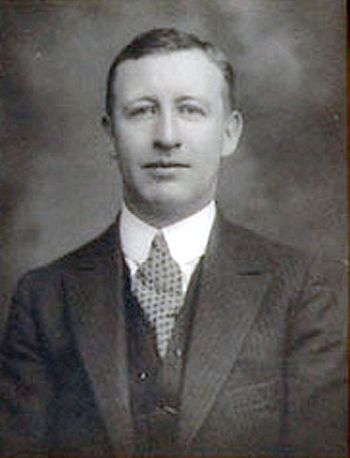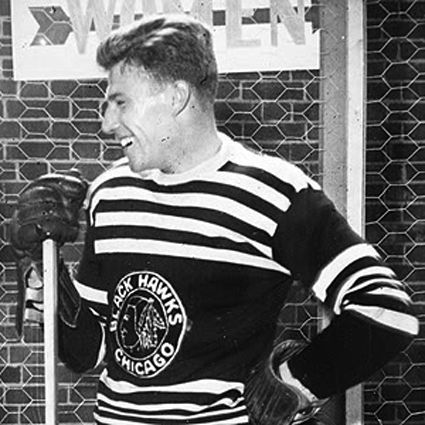Saturday, March 19, 2016
1980-81 Buffalo Sabres Gilbert Perreault Jersey
On this date in 1981, the Buffalo Sabres hosted the Toronto Maple Leafs. Starting in goal for the Maple Leafs that evening was Michel "Bunny" Larocque.
He would not finish the game.
The game started out ordinarily enough, with the first notable event being a minor penalty to Wilf Paiement
at 2:13 of the first period. Toronto was later called for having too
many men on the ice at 5:16, still in the first. During the ensuing
power play John Van Boxmeer would capitalize on the
man advantage for Buffalo with his 16th goal of the season, unassisted,
at 6:25. That would remain the only goal of the period, despite
subsequent penalties to Toronto's Barry Melrose at 11:02 and the Sabres Larry Playfair at 17:48. The period would end with Buffalo being credited with 8 shots on goal while Don Edwards made saves on all 6 of Toronto's shots.
John Van Boxmeer
Melrose
picked up his second minor of the game at exactly 2 minutes of the
second period, which the Maple Leafs killed off successfully. Gilbert Perreault
then put the Sabres up 2-0 with his 14th goal of the season at 4:27,
shortly after Melrose's penalty had expired. At 6:01, Buffalo's Steve Patrick and Ian Turnbull of Toronto were both sent off for matching minors. Derek Smith then extended the Buffalo lead to 3-0 when he scored his 20th goal of the season with assists from Tony McKegney and Jim Schoenfeld at 8:46, which was a precursor for things to come, and come they did in rapid succession.
Derek Smth
Ric Seiling's 25th goal of the season, from Craig Ramsey and Andre Savard
at 10:27 pushed the Sabres lead up to 4-0 at 10:27 as all hell broke
loose. Perreault followed with his second goal of the period,
unassisted, at 11:12. Darryl Sittler responded with the first Maple Leafs goal 11 seconds later from Paiement to make it 5-1, only to have Terry Martin net another for Toronto 31 seconds later, from Paiement and Turnbull for the fourth goal in under a minute and a half.
Ric Seiling
Ramsay
took back some of the Maple Leafs momentum another minute and a half
later with his 22nd goal from Seiling and Savard at 13:24. Bill Hajt
was sent off for two minutes at 13:37 but Toronto only needed less than
30 seconds to capitalize when Sittler scored his second of the period
and 43rd of the season from Borje Salming and Turnbull at
14:06, the first power play goal of the eight scored so far in the
second period which now saw the score at 6-3 for the home Sabres.
The
offensive fireworks were not over though, as Savard's 25th, from
McKegney and Seiling at 15:50 was followed by Perreault completing his
hat trick in a span of 13:15 from Van Boxmeer and Playfair at 17:42. The
Sabres captain and eventual leading scorer for the season Danny Gare finally got into the act with his 39th goal from Smith and Lindy Ruff at 18:51 to tie the NHL record for Most Goals in a Period with 8.
Gilbert Perreault
Less
than a minute later at 19:47, Savard's second of the period and 26th of
the season, from Seiling and Hajt gave Buffalo the outright record of
nine goals scored in a single period to make the score 10-3 in favor of
the Sabres, with all nine of the record setting goals coming at even
strength and having been given up by the unfortunate Larocque on 19
Buffalo shots in the second.
The shell-shocked Bunny Larocque
The
Sabres also equalled a record held by the 1970-71 New York Rangers as
well as the 1974-75 Sabres (both of whom had 8 goals and 15 assists)
when they registered their 23rd point of the period, led by Savard's 4
points, from 2 goals and 2 assists, Seiling's 4 points (1 goal and 3
assists) as well as Perreault's hat trick. Smith and Ramsay each had a
goal and an assist, while McKegney was credited with a pair of assists
as well. Gare contributed his goal, while Schoenfeld, Van Boxmeer,
Playfair, Ruff and Hajt each had an assist in the second for a total of
23 points.
Mercifully, Larocque was given the rest of the night off to recover from his debacle, replaced for the third period by Czech Jiri Crha.
The
remainder of the game saw ten minors and two misconducts as play got
rough, which led to a pair of power play goals, the first for Toronto at
4:34 of the third. Smith's second goal at 10:47 also came with the man
advantage from Gare and Van Boxmeer at 10:47. Gare struck again 36
seconds later for his 40th goal of the season from Van Boxmeer and
McKegney at 11:23.
The scoring was wrapped up with a goal by Gilles Hamel
from Savard and Playfair at 15:26 before Savard completed a hat trick
of his own, his 27th of the season, from Playfair and Perreault at 18:49
to make the final score 14-4 in favor of the Sabres, much to the
delight of the 16,433 Sabres faithful in attendance, but probably not
the official scorekeeper and the public address announcer, who surely
had trouble keeping up that evening!
In
all, 13 Sabres featured in the scoring, led by Savard's 6 point night
from 3 goals and 3 assists. Three other Sabres had 4 points, those being
Perreault, Seiling and defenseman Van Boxmeer. Others with multiple
point games included Smith, McKegney, Playfair and Gare with 3 and
Ramsay with 2 points.
Edwards got
the easy win in goal for Buffalo despite giving up 4 goals on 32 shots,
while Larocque obviously got the loss thanks to allowing ten goals,
while Crha let in 4 on 22 shots, as the Sabres did little to take their
foot off the gas in the final period.
Today's
featured jersey is a 1980-81 Buffalo Sabres Gilbert Perreault jersey as
worn during his second period hat trick as part of the Sabres record
setting 9 goal second period on this date in 1981. Obscured by the left
arm of the jersey is the assistant captain's "A", as Perreault would not
become the club's captain until the following season when current
captain Gare departed via a trade.
The
original 1970-71 Sabres jerseys had no names on the back and a lace up
collar, with names arriving in 1977-78 by league rule. The Sabres logo
was repeated on the shoulders beginning in 1978-79, the same season the
collars changed to a v-neck.
Today's video segment begins with a profile on the Sabres captain Gare.
Next, the Legends of Hockey profile of Perreault.
Labels:
Buffalo Sabres,
Perreault Gilbert
Friday, March 18, 2016
1944-45 Montreal Canadiens Maurice Richard Jersey
In the 1942-43 season, the NHL consisted of seven teams playing a 48 game schedule. The Brooklyn Americans would cease operations following that season, leaving the NHL with just six teams, who would now play a 50 game schedule starting with the 1943-44 campaign. Doug Bentley would lead the NHL in goals that season with 38, six shy of the current NHL record of 44, held by Joe Malone since way back in 1918.
The 1944-45 season was only the third NHL season for Maurice Richard. He had broken in with Montreal in 1942-43 with just 5 goals in only 16 games played due to a leg injury which ended his rookie season on December 27th. He established himself as an NHL regular in 1943-44 with 32 goals in 46 games as the Canadiens would go on to capture the Stanley Cup, but Richard had more memorable moments in store for the Montreal faithful the following season.
He started out slowly with just nine goals in the first 28 games, but came on strong with 23 goals in his last 18 games. It came down to the final day of the season on this date in 1945, as Richard's total stood at 49. He had already surpassed Malone's 27-year-old single season record with his 45th goal, but now had his sights set on a record many thought unattainable - 50 goals in 50 games.
In fact, the night before, referee King Clancy had disallowed a Richard goal, preventing him from reaching the magic 50 goal mark.
During the first two periods, the Canadiens opponents that night, the Boston Bruins, kept a close watch on Richard, keeping him off the scoreboard for both the first and second periods, leaving the score tied at 1-1.
The Bruins gained the lead with a goal in the third, but with 2:15 to play in the final game of the season, Richard broke through and fired the puck past Bruins goaltender Harvey Bennett to become the first 50 goal scorer in National Hockey League history.
Despite his record setting goal total, Richard would come second in the NHL scoring race, as Canadiens teammate Elmer Lach would beat Richard to the scoring title by seven points, 80-73.
Richard celebrates his 50 goals in 50 games
Despite his record setting goal total, Richard would come second in the NHL scoring race, as Canadiens teammate Elmer Lach would beat Richard to the scoring title by seven points, 80-73.
Fellow "Punch Line" member Toe Blake's 67 points meant, for only the second time ever, an entire line finished 1-2-3 in scoring, first accomplished in 1940 by Boston Bruins trio of Milt Schmidt (52 points), Bobby Bauer (43) and Woody Dumart (43) who were known as the "Kraut Line".
The "Punch Line" - Richard, Lach and Blake
In addition to scoring 50 goals in 50 games, another notable highlight of Richard's season would come on December 28, 1944, with five goals and three assists to set a new NHL single game scoring record with an eight point night at home against the Detroit Red Wings - this on a day he missed the morning skate after moving furniture into his new home and he had to convince coach Dick Irvin to put him into the lineup!
Richard would never duplicate 50 goals in the remaining 15 seasons of his career. The closest he would come would be 45 goals in 1947, a season expanded to a now 60 game schedule. Not even the 70 games played in 1949-50 would allow Richard to attain more than the 43 he scored that season for the third best of his career.
Richard would become the first to reach 500 goals in league history on October 19, 1957, aided in part by his leading the league in goal scoring on five separate occasions. Curiously, he never led the league in overall scoring as he came in second a tantalizing five times.
Even though Richard would bring the Stanley Cup to Montreal eight times, including a remarkable five in a row to finish out his career, his status as a legend was cemented early on when he became the first to reach 50 goals in 50 games in only his third season.
It would take another 16 years for any other player to duplicate Richard's 50 goals, when Bernie Geoffrion did it in 64 games in 1960-61, and not until Mike Bossy dramatically scored twice in the final five minutes of his 50th game of the 1980-81 season did anyone match Richard's feat of 50 in 50 some 35 years later.
Since that time, Wayne Gretzky achieved it three times, the first of which was accomplished in an amazing 39 games, as Gretzky scored nine times in two games to vault from 41 goals to the 50 mark. Additionally, Mario Lemeiux did it once and Brett Hull twice to join one of hockey's most exclusive clubs, which remains just five in number since 1992, now a span of 22 seasons and counting.
Today's featured jersey is a 1944-45 Montreal Canadiens Maurice Richard jersey. It's rare that we feature a jersey when we only have access to a photo of just one side, but we felt in the case of this historically significant sweater it was a no-brainer.
Careful examination of this Canadiens sweater will show that the red shoulder yoke takes a notch out of the blue arm band, most easily seen on the left sleeve. This variation began with the 1939-40 season and in 1941-42, the red, white and blue rounded collar changed to an all white lace-up collar, which would last through the 1946-47 season, after which the blue sleeve stripes would no longer have a bite taken out of them by the shoulder yoke.
Also noteworthy on this amazing sweater is the back-and-forth looping stitching on the number 9 on the back as seen in the lower photo.
Careful examination of this Canadiens sweater will show that the red shoulder yoke takes a notch out of the blue arm band, most easily seen on the left sleeve. This variation began with the 1939-40 season and in 1941-42, the red, white and blue rounded collar changed to an all white lace-up collar, which would last through the 1946-47 season, after which the blue sleeve stripes would no longer have a bite taken out of them by the shoulder yoke.
Also noteworthy on this amazing sweater is the back-and-forth looping stitching on the number 9 on the back as seen in the lower photo.
Here is a look back at Richard's 1944-45 season in which he became the first to score 50 goals in 50 games.
Labels:
Montreal Canadiens,
Richard Maurice
Thursday, March 17, 2016
Hockey's First Dynasty - the Original Ottawa Senators
The original Ottawa Senators were founded back in 1883 as an amateur club, later becoming a professional team. In the early years of hockey the club moved from league to league as the organization of early hockey was still finding it's feet.
Aside from the changes in leagues, the club also took some time to settle on a permanent nickname as well. Known as the Generals in the 1890's, the club was known as the Silver Seven from 1903 to 1907 before adopting the name Senators starting in 1912.
Today's featured jersey is a 1927-28 Ottawa Senators Frank Nighbor jersey. Back in the early days of professional hockey, the Senators made it a habit of celebrating their status as World's Champions by wearing a commemorative patch on their jerseys the following season, as was the case in 1921-22, 1923-24 and 1927-28.
The Senators trademark red, black and white horizontal "barberpole" stripes were first adopted in 1903, and except for one season with vertical stripes in 1910-11, remained in use through the original Senators final season in Ottawa of 1933-34, with the addition of the letter "O" crest from 1929-30 on.
Nighbor signed with Ottawa for the 1915-16 season and immediately led the team in scoring his first season and the entire NHA in his second. He won a Stanley Cup with the Senators in both 1920, 1921, 1923 and1927.
He was named the first recipient of the Hart Trophy as the NHL's Most Valuable Player and also the first to be awarded the Lady Byng Trophy by Lady Byng herself in a surprise presentation in 1925 and won it again in 1926. He was one of the players sold during the Senators financial decline, having been sent to the Toronto Maple Leafs during the 1929-30 season and was elected to the Hockey Hall of Fame in 1947.
Today's video section is a brief recap of the original Senators history and how it influenced the branding of the newly reborn Senators.
Aside from the changes in leagues, the club also took some time to settle on a permanent nickname as well. Known as the Generals in the 1890's, the club was known as the Silver Seven from 1903 to 1907 before adopting the name Senators starting in 1912.
One of the most successful teams in the early days of hockey, the club won their first Stanley Cup in 1903 when they defeated the Montreal Victorias in a two-game, total goals series. Game 1 finished in a 1-1 tie, but Ottawa roared to life and dominated the second game 8-0 led by Frank McGee's hat trick and two goals each by Dave Gilmour and Suddy Gilmour plus a single goal by Bill Gilmour. As a result of their 9-1 triumph, Ottawa became league champions were
declared holders of the cup for the first time in club history.
The club would regain the Stanley Cup in March of 1909 when they won the ECHA regular season championship, taking control of the trophy from the Wanderers. In January of 1910, the team would turn back challenges from the Galt Hockey Club 15-4 in a two-game, total goals series and then the Edmonton Hockey Club 21-11 in another two-game, total goals series.
The team joined the National Hockey Association, in 1910 and regained the Stanley Cup again as the 1911 NHA champions, once more relieving the rival Wanderers of the cup. Three days later they again turned back a challenge from Galt HC 7-4 and and another three days later the Port Arthur Bearcats were thrashed 13-4, with both contests being single elimination games for the rights to the cup, their last as the Silver Seven and their last of the cup's "challenge era".
Two days later the new champions were challenged for their new
trophy by the Rat Portage Thistles in a best-of-three series. Game 1
went to Ottawa 6-2, with McGee scoring twice. Two days later, Ottawa
successfully defended their trophy with a 4-2 win, with McGee scoring
twice more, including the cup winning goal at 8:20 of the first half, as
the game had yet to be divided into three periods. As a reward for
their victory, each member of the squad would receive a silver nugget,
which gave birth to the team's new nickname - The Silver Seven.
The Stanley Cup champion 1903 Ottawa Hockey Club
Before the 1904 CAHL season began, Ottawa
faced another challenge for the Stanley Cup, this from the Winnipeg
Rowing Club. A best-of-three series, play began on December 30th, 1903.
When the series concluded on January 4, 1904, the Silver Seven prevailed
after a 9-1 win, a 6-2 loss and a 2-0 shutout in Game 3.
Ottawa
had a tumultuous 1904 season, as they withdrew from the CAHL after only
four games and joined the new Federal Amateur Hockey League but did
not participate in any of the FAHL regular season games.
After
leaving the CAHL, the Silver Seven would face a cup challenge from the
Toronto Marlboros, who they turned away 2 games to none in their
best-of-three challenge in late February of 1904.
Once
the FAHL regular season was concluded, it's regular season champions,
the Montreal Wanderers met the Silver Seven to compete in a two-game,
total-goal series for the FAHL championship and the rights to the
Stanley Cup that went with it. At least that was the plan. The first
game ended in a 5-5 tie when the Wanderers refused to play overtime with
the same referee in charge and then had the temerity to demand the
series begin anew as a best-of-three! When the trustees of the cup
ordered the series to continue as planned, the Wanderers abandoned their
challenge, leaving the Silver Seven as FAHL champions despite their
having played but a single tie game in league competition!
A
final challenge to Ottawa was arranged for one week later, this from
Brandon Wheat Cities in another best-of-three format, which the Silver
Seven turned away with a pair of victories. While McGee had only played
in four regular season games during the 1904 season, he skated in eight
cup challenge games, scoring 21 times as the Silver Seven turned away no
less than four separate challengers.
In
their first full season of FAHL competition in 1905, Ottawa came first
with a 7-1 record as McGee would tie for the league lead with 17 goals. The highlight of McGee's regular season would be a five goal performance on February 4th.
During
the season, the Dawson City Nuggets would travel 4,000 miles from the
Yukon to challenge Ottawa. Their trip would take a month to complete and
include traveling on foot, by sled dog, automobile, ship and train.
Game 1 of the best-of-three would go to Ottawa by a score of 9-2. Game 2 would be one for the
ages, as Ottawa continued to pile up goals at a furious pace, eventually
winning by an unfathomable 23-2 final score with McGee setting a record
which still stands today, as he scored an incredible 14 times! Eight of
McGee's goals were consecutive and came in under nine minutes of
playing time.
As league
champions, Ottawa retained the cup and was challenged once again by the
Rat Portage Thistles. Game 1 was won by the
Thistles 9-3 but Ottawa retained the cup by winning Games 2 and 3 by scores of 4-2 and 5-4.
The Stanley Cup champion 1905 Ottawa Silver Seven
For
the 1906 season, the Silver Seven moved to the new Eastern Canada
Amateur Hockey Association. They tied for the best record at 9-1.
Ottawa
would face two challenges during the regular season, first from Queen's
University in a best-of-three. After Game 1 went the way of the Silver
Seven 16-7, there was little doubt that the cup would remain with the Silver Seven,
which was confirmed by a 12-7 score in Game 2.
Just prior to the end
of the regular season, Ottawa again had to face a cup challenge, this
time from Smiths Falls in another best-of-three series. Ottawa had little
trouble defending it's now three year grip on the Stanley Cup, as they
won two straight by scores of 6-5 and 8-2. In all, McGee scored 15 times
in the four cup challenge games that season.
The ECAHA playoffs took place on March
14th and 17th, 1906. The series was a two-game, total-goal affair. The
Montreal Wanderers put in an early claim on the cup with a resounding
9-1 win in the first game.
Ottawa
was down, but not out, as they entered Game 2, but 12 minutes in,
Montreal scored again to increase their lead to nine goals. McGee got
Ottawa on the board in the first half and again before the half ended to
help cut the margin to 10-4. The Silver Seven would come out flying in
the second half, and score six consecutive goals to even the series at
10-10! In the final seven minutes of the contest, Lester Patrick
would score to put Montreal in front and then end the three year reign
of the Silver Seven with an empty net goal in the final seconds.
The club would regain the Stanley Cup in March of 1909 when they won the ECHA regular season championship, taking control of the trophy from the Wanderers. In January of 1910, the team would turn back challenges from the Galt Hockey Club 15-4 in a two-game, total goals series and then the Edmonton Hockey Club 21-11 in another two-game, total goals series.
The team joined the National Hockey Association, in 1910 and regained the Stanley Cup again as the 1911 NHA champions, once more relieving the rival Wanderers of the cup. Three days later they again turned back a challenge from Galt HC 7-4 and and another three days later the Port Arthur Bearcats were thrashed 13-4, with both contests being single elimination games for the rights to the cup, their last as the Silver Seven and their last of the cup's "challenge era".
After the NHA dissolved, the Ottawa Senators joined the brand new National Hockey League as a charter member in 1917. They soon rose to prominence, capturing four more Stanley Cups, with the first being in 1920 over the Seattle Metropolitans 3 games to 2, they retained the cup in 1921 over the Vancouver Millionaires 3 games to 2, and again in 1923 over the Edmonton Eskimos 2 games to none during the era from 1915 to 1922 when the NHL champion would take on the champion of the Pacific Coast Hockey League and later from 1923 to 1926 the Western Canada Hockey League.
After winning the championship in 1927, which by now saw the cup in the sole possession of the NHL, by defeating the Boston Bruins by virtue of 2 wins and 2 ties, the Senators began a decline in fortunes, primarily due to the small size of Ottawa when compared to the other cities in the league at the time.
Ottawa's population in 1931 was 110,000, one-fifth the size of Toronto, which was the second smallest NHL city at the time. They began to sell off their best players, suffered from low attendance at home against new expansion teams, such as the Boston Bruins, Chicago Black Hawks, Detroit Cougars, New York Americans, New York Rangers and the Pittsburgh Pirates, as well as the higher travel costs to play those same teams all of which were located in the United States.
The Stanley Cup champion 1926-27 Ottawa Senators
Ottawa's population in 1931 was 110,000, one-fifth the size of Toronto, which was the second smallest NHL city at the time. They began to sell off their best players, suffered from low attendance at home against new expansion teams, such as the Boston Bruins, Chicago Black Hawks, Detroit Cougars, New York Americans, New York Rangers and the Pittsburgh Pirates, as well as the higher travel costs to play those same teams all of which were located in the United States.
The Great Depression also affected the team and caused the sale of even more players, including King Clancy to Toronto. Things got so bad that the team suspended operations for the 1931-32 season and returned to finish with the worst record in the league two years in a row in 1932-33 and 1933-34. with their final game coming on this date in 1934, a 2-2 tie against the Montreal Maroons.
The owner of the franchise then announced that it would not return to Ottawa for the 1934-35 season due to losses of over $60,000 since resuming play and that he would be relocating the team to St. Louis for the 1934-35 season.
The renamed Eagles fared little better financially in St. Louis however, with long, expensive train trips to New York and Boston as well as a large number of games against Montreal and Toronto, as the poor Eagles were forced to take Ottawa's place in the Canadian Division of the NHL, despite being located much closer to Chicago and Detroit of the American Division.
The owner of the franchise then announced that it would not return to Ottawa for the 1934-35 season due to losses of over $60,000 since resuming play and that he would be relocating the team to St. Louis for the 1934-35 season.
The renamed Eagles fared little better financially in St. Louis however, with long, expensive train trips to New York and Boston as well as a large number of games against Montreal and Toronto, as the poor Eagles were forced to take Ottawa's place in the Canadian Division of the NHL, despite being located much closer to Chicago and Detroit of the American Division.
The club finished with a dismal record of 11-31-6 for last in the league, and after just one season, the owners of the franchise sold the club back to the NHL for $40,000 and the players were then sold off to the remaining eight clubs in the league, bringing an end to one of the mightiest franchises of hockey's formative years.
It would be 58 years before the league would come back to Ottawa in 1992 with the new incarnation of the Senators.
Today's featured jersey is a 1927-28 Ottawa Senators Frank Nighbor jersey. Back in the early days of professional hockey, the Senators made it a habit of celebrating their status as World's Champions by wearing a commemorative patch on their jerseys the following season, as was the case in 1921-22, 1923-24 and 1927-28.
The Senators trademark red, black and white horizontal "barberpole" stripes were first adopted in 1903, and except for one season with vertical stripes in 1910-11, remained in use through the original Senators final season in Ottawa of 1933-34, with the addition of the letter "O" crest from 1929-30 on.
Nighbor signed with Ottawa for the 1915-16 season and immediately led the team in scoring his first season and the entire NHA in his second. He won a Stanley Cup with the Senators in both 1920, 1921, 1923 and1927.
He was named the first recipient of the Hart Trophy as the NHL's Most Valuable Player and also the first to be awarded the Lady Byng Trophy by Lady Byng herself in a surprise presentation in 1925 and won it again in 1926. He was one of the players sold during the Senators financial decline, having been sent to the Toronto Maple Leafs during the 1929-30 season and was elected to the Hockey Hall of Fame in 1947.
Labels:
Ottawa Senators,
St. Louis Eagles
Wednesday, March 16, 2016
1946-47 Detroit Red Wings Billy Taylor Jersey
While playing for the Oshawa Generals of the Ontario Hockey League, Billy Taylor began his junior career with 19 goals in 12 games during the 1937-38 season. During the Generals run to the Memorial Cup Finals, Taylor scorched the ice with 17 goals and 19 assists for 36 points in just 13 playoff games, a 2.77 points per game average as a rookie.
He picked up where he left off during the following season, scoring 22 goals and 53 points in 14 games. He helped lead Oshawa to their first Memorial Cup championship with 11 goals and 28 points in nine games, topping the 3 point per game average this time out.
Taylor competed for the Pittsburgh Hornets of the International-American Hockey League prior to making his NHL debut with 29 games with the Toronto Maple Leafs during the 1939-40 season. Over the course of the next three seasons, Taylor's scoring totals continued to rise, going from 35 to 38 in 1941-42, a season during which he won the Stanley Cup, and then finally 60 points from 18 goals and 42 assists during the 1942-43 season, good for sixth in the NHL scoring race.
His NHL career was interrupted by performing military service from 1943 to 1945, although he found the time to play for the Newmarket Army team as well as the Toronto Army Shamrocks in 1944-45, with his NHL quality talent scoring 29 points in 8 regular season games and topping that with 32 points in 8 playoff contests, a four point per game average.
Back in the NHL in 1945, Taylor did not miss a beat, as he set a career high in goals with 23 on his way to 41 points in 48 games.
Just prior to the start of the 1946-47 season, he was traded to the Detroit Red Wings where he immediately led the team in scoring with a career best 63 points from 17 goals and league leading 46 assists, which included an NHL record seven assists in a 10-6 Detroit win against Chicago on this date in 1947, a record which still endures today.
The 1946-47 Detroit Red Wings with Taylor first on the left in the front row
and rookie Gordie Howe fourth from the left in the back row
Despite leading the Red Wings in scoring, Detroit traded Taylor to the Boston Bruins for the 1947-48 season. He skated for the Bruins for 39 games until being traded to the New York Rangers on February 6th of that season. Taylor would only play two games for New York until being suspended for life by NHL President Clarence Campbell for violating the league's rules on gambling. Taylor's suspension was eventually lifted on August 25, 1970.
His career concluded with 323 games played, 87 goals and 180 assists for 267 points during a career interrupted by World War II and cut short by his suspension.
Today's featured jersey is a 1946-47 Detroit Red Wings Billy Taylor jersey as worn during his only season with the Red Wings. Detroit first wore their classic red jersey in 1932 when the club's name was changed from the Falcons to the Red Wings.
The jerseys were originally worn with red numbers trimmed in white for the first four seasons prior to changing to single color white numbers, which remain in use nearly 75 years later.
Of note, is the unusual treatment of the assistant captain's "A", which is contained in a diamond shape, something the Red Wings reprized in 1991-92 with their Turn Back the Clock jerseys worn during the NHL's 75th anniversary season.
Labels:
Detroit Red Wings,
Taylor Billy
1965-66 Montreal Canadiens Jean Beliveau Jersey
Led by captain Jean Beliveau, the 1965-66 Montreal Canadiens were the defending Stanley Cup champions, having broken the string of three consecutive championships won by the Toronto Maple Leafs from 1962 to 1964.
Montreal started out well enough in 1965-66, winning their first three before a loss to the Chicago Black Hawks. After a tie with the Detroit Red Wings, the Canadiens met the Maple Leafs for the first time on November 4, 1965, which went the way of Montreal by a comfortable 5-1 score. A win and a tie against the Boston Bruins followed before their next game against the Maple Leafs, which ended in a 3-3 deadlock.
Another win against Chicago followed by their second tie of the season against Detroit preceded a third meeting with Toronto on November 18th. The Maple Leafs were led by captain George Armstrong and entered the game at 3-6-2 and needed a win to keep pace with the Canadiens, who were now at 6-2-3, already 7 points ahead in the standings. Trailing 1-0 after two periods, Toronto shocked the fans at the Forum with a trio of third period goals to take the game 3-1 and stay within 5 points of the Canadiens.
The Canadiens rebounded with a win over the New York Rangers 9-3 followed by a 3-2 loss the next night after having to travel to Boston. Montreal then went on a run of four wins, which began with a 2-1 win at Toronto, a 4-4 tie in Boston and three more wins to cap off a eight game undefeated streak, which was comprised of 7 wins and a tie to push the Canadiens record to 14-4-4.
The streak was ended by the Maple Leafs on December 16th, who again won in Montreal by a score of 3-2. The Maple Leafs were now in the midst of a ten game undefeated streak of their own, which improved their record from 7-10-3 on December 5th to 15-10-5 by New Year's Day.
The loss to Toronto began a period of five weeks mediocre play for Montreal, as they would close out 1965 by alternating wins and losses for four games before dropping another to the now streaking Maple Leafs on December 29th, again by a 3-2 score, only this time at Maple Leaf Gardens.
The start of the new year looked promising for Montreal with a pair of wins over the Rangers, giving Montreal 40 points at 18-8-4, while Toronto stood at 15-10-5, just five points back after trailing by 12 on December 12th. Montreal was not out of their funk however, as they dropped six of their next 10, including a 6-0 pasting by the Maple Leafs on January 13th at home, which ended a three game losing streak for Toronto.
Montreal finally found their game beginning on January 29th with a 6-2 win over the Rangers, followed by a 3-1 win over Boston and a 5-4 decision over the Maple Leafs, including the final three goals of the game to come from behind to win. A tie with Detroit and a win over the Rangers, pushing their record to 8-1 against the Blueshirts, extended their run to five games without a loss.
A loss, a tie and a win preceded another meeting with Toronto, who took a 3-1 win at home.
Chicago, New York, Boston, New York again and Detroit all fell to the Canadiens before a tie with Toronto ran Montreal's latest streak to six games without a loss and gave them 70 points from a 31-16-8 record. The Maple Leafs broke the streak with a 4-0 win in Montreal, their fourth win of the season at the Forum as they were now in the midst of another hot streak which would stretch to 9 games without a loss from 7 wins and a pair of ties. The win over Montreal left Toronto at 26-20-9 and 61 points.
Montreal would win three of their next five before their next meeting with Toronto on this date in 1966 at Toronto. Their 76 points leading the Maple Leafs by 7.
Bobby Rousseau would open the scoring with his 26th goal of the season just nine seconds into the game from Ted Harris and Beliveau followed by Gilles Tremblay's goal from Beliveau and Claude Pronovost just 31 seconds later giving Montreal a 2-0 lead less than a minute into the game.
Claude Larose added another goal at 16:37 from Dale Balon before Ron Ellis got Toronto on the board 30 seconds later with an assist from Pete Stemkowski to close out the first period at 3-1 for the visitors.
Claude Larose added another goal at 16:37 from Dale Balon before Ron Ellis got Toronto on the board 30 seconds later with an assist from Pete Stemkowski to close out the first period at 3-1 for the visitors.
At the five minute mark of the second period, Beliveau's 25th goal of the season from Rousseau and Dick Duff pushed the Montreal lead back to three with the first power play goal of the game to chase Johnny Bower from the Maple Leafs goal.
Dave Keon struck back for Toronto just 20 second later from Frank Mahovlich and Tim Horton to shrink the lead back to 3, only to have Beliveau respond with a goal after just another 23 seconds play from Gilles Tremblay and Pronovost to rudely greet Toronto's new goaltender Bruce Gamble just 43 seconds after he entered the game. Ralph Backstrom's 18th goal of the season from Claude Larose arrived 22 ticks of the clock later to set a new NHL record for the fastest four goals, all within one minute and five seconds!
Dave Keon struck back for Toronto just 20 second later from Frank Mahovlich and Tim Horton to shrink the lead back to 3, only to have Beliveau respond with a goal after just another 23 seconds play from Gilles Tremblay and Pronovost to rudely greet Toronto's new goaltender Bruce Gamble just 43 seconds after he entered the game. Ralph Backstrom's 18th goal of the season from Claude Larose arrived 22 ticks of the clock later to set a new NHL record for the fastest four goals, all within one minute and five seconds!
The Canadiens would add one more goal in the third period to make the final 7-2 in favor of Montreal. They would defeat the Rangers yet again before losses at Chicago and home to Toronto before they would finish the season with a five game winning streak to end the year at 41-21-8, good for 90 points and a first place finish during the regular season, 8 points up on Chicago and 11 ahead of the Maple Leafs, although Toronto would take the season series 5-7-2, including 5 wins in Montreal.
Rather than the expected 1 versus 4 and 2 against 3 pairings in the playoffs, the format of the day for some reason paired #1 against #3, and #2 versus #4, setting up a Montreal vs. Toronto first round matchup.
Montreal took Game 1 at home by a score of 4-3 after Beliveau's goal with 2:12 remaining. Gump Worsley shut out the Maple Leafs in Game 2 as a pair of third period goals by Montreal were enough for a 2-0 win at the Forum. After Toronto jumped out to a 2-0 lead after one at home in Game 3, Montreal responded with three goals in the second and two more in the third to win going away 5-2 and then closed out the series with a 4-1 win following a penalty filled first period that saw a dozen majors, six misconducts and a pair of minors in a huge brawl just 3:37 into the game, in which Toronto again led after one, 1-0, before Montreal scored a pair of power play goals by Tremblay in the second and a shorthanded goal and another power play goal in the third to advance to the finals.
Montreal would eventually win their second consecutive Stanley Cup after falling behind 2 games to none before roaring back with four straight wins to take the title.
The 1965-66 Stanley Cup champion Montreal Canadiens
Today's featured jersey is a 1965-66 Montreal Canadiens Jean Beliveau jersey. Believau was a ten time Stanley Cup champion with Montreal in his 20 years with the club. In addition to being the first Conn Smythe Trophy winner as playoff MVP in 1965, Beliveau also won the Art Ross Trophy as scoring champion in 1956 and the Hart Trophy as MVP in 1956 and 1964. Had the Conn Smythe Trophy been in existence prior to the 1965 finals, odds are that Beliveau would have won at least one more, particularly in 1956 when he led the Canadiens in playoff scoring with 12 goals and 19 points in just ten games.
A white Canadiens jerseys first arrived on the scene in 1935-36 and was worn only for games against the Red Wings. After some changes in striping, the first red shoulder yoke appeared in 1941-42. After three seasons, a new white sweater with a blue band trimmed in red around the chest arrived, which was used for three seasons until a return to the white jersey with the red shoulder yoke, which remains in use to this day.
Today's first video is a terrific find, footage of Beliveau being the first man to ever receive the Conn Smythe Trophy in 1965.
Next is the Top Ten Conn Smythe Trophy winners and a look at each of their spectacular playoff performances.
Labels:
Beliveau Jean,
Montreal Canadiens
Tuesday, March 15, 2016
1950-51 Detroit Red Wings Terry Sawchuk Jersey
Goaltender Terry Sawchuk idolized his older brother Mitch, who wanted to be a goaltender. Sadly, at just seventeen years of age, Mitch died of a heart attack. After inheriting his older brother's goalie equipment Terry began playing hockey in a local league and began to excel to the point that at age 14 a local scout for the Detroit Red Wings had Sawchuk work out for him and later signed Terry to an amateur contract to play for their junior team.
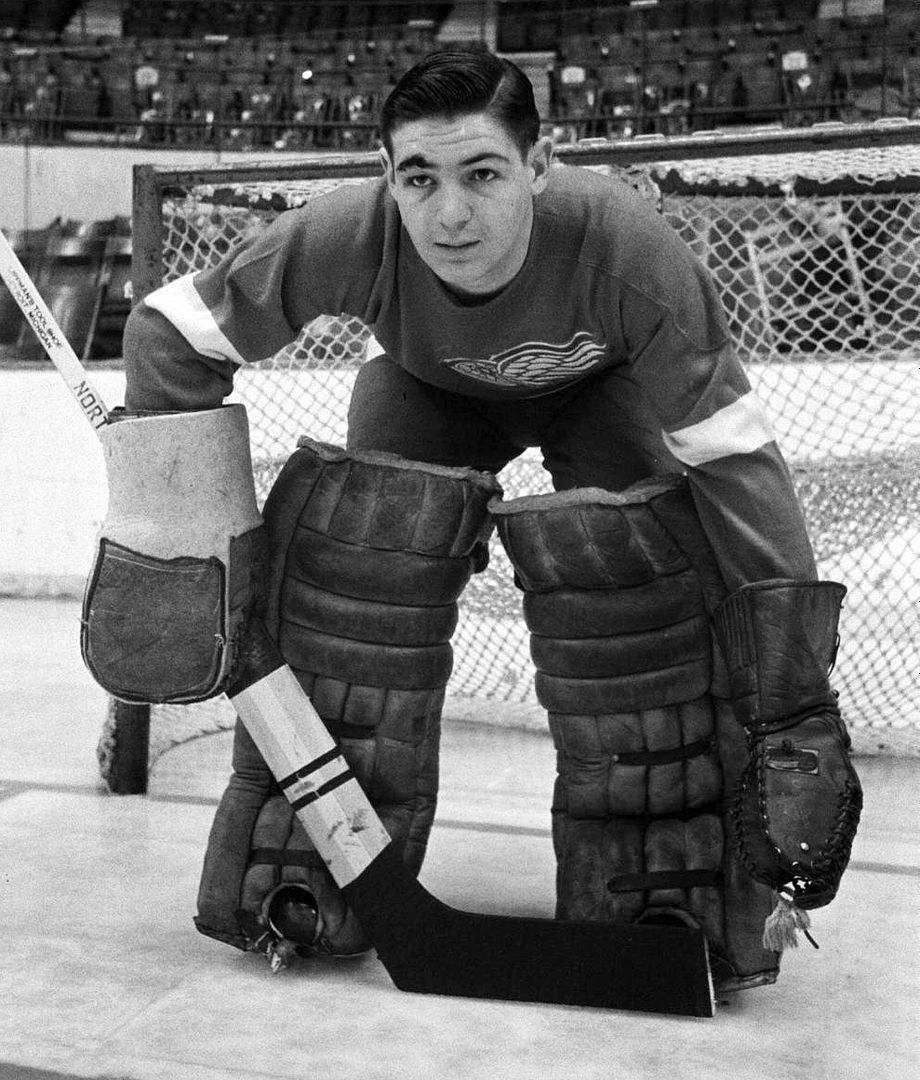
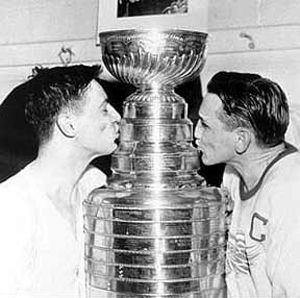
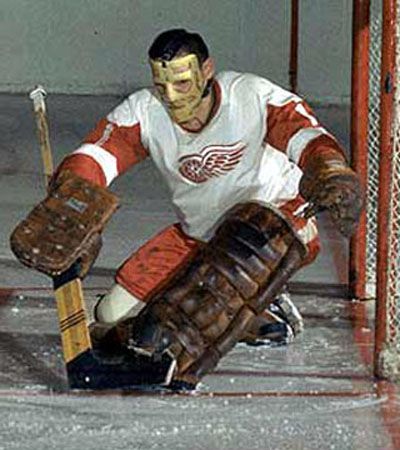
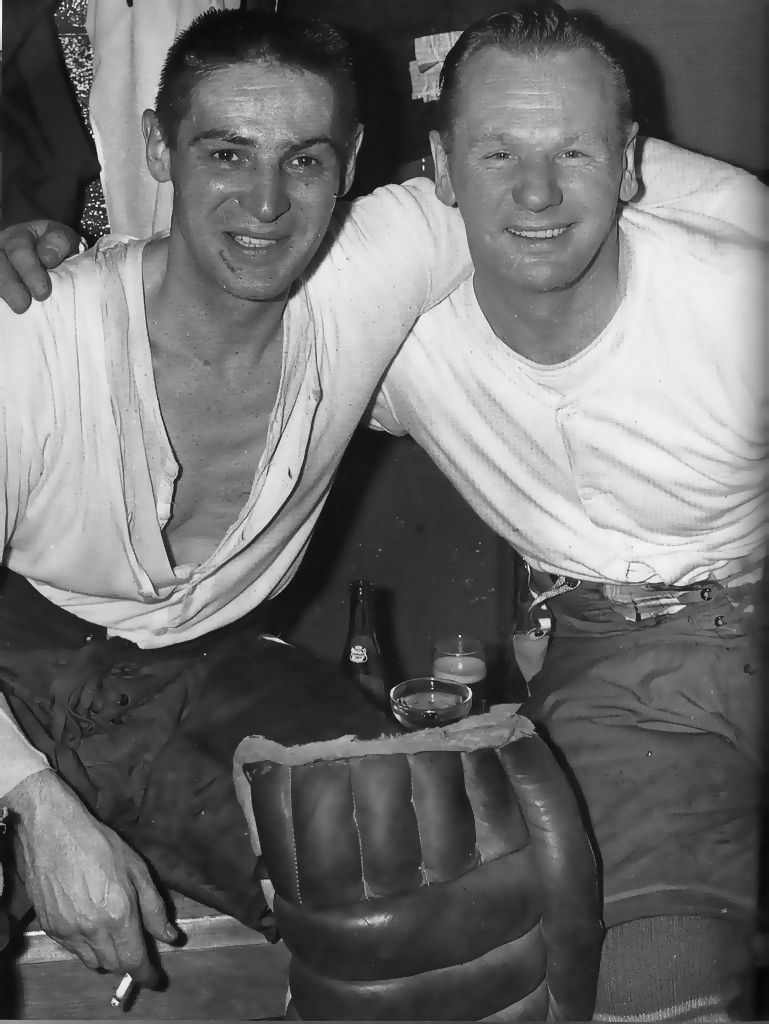
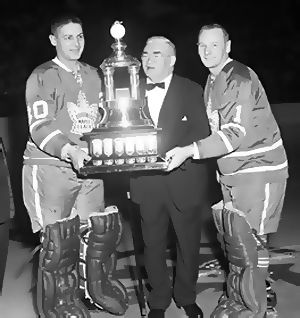
Bonus jersey: Today's bonus jersey is a 1961-62 Detroit Red Wings Terry Sawchuk jersey. From 1932 to 1934, the Red Wings only wore red sweaters for both home and road games, with the white jersey not being introduced until the 1934-35 season. The next real change of note was the addition of red sleeves decorated with sleeve numbers for the first time in 1961, as seen on today's bonus jersey. Names would not appear until 1973 with only changes to fonts for the name and numbers since.
Sawchuk turned pro with Detroit during the later part of the 1949-50 season, filling in for the injured Harry Lumley, who would return in time to lead the Red Wings to the 1950 Stanley Cup championship. Despite winning the championship, Lumley was traded to the Chicago Black Hawks, promoting Sawchuk to the Red Wings goaltending job in time for the 1950-51 season despite having only seven games of NHL experience.

The Red Wings faith in Sawchuk would immediately pay off, as he would record the 10th shutout of his rookie season on this date in 1951 while becoming the first goalie in NHL history to win 40 games in one season as Detroit defeated the Boston Bruins 4-0.
At the conclusion of his rookie year, he would finish with a record of 44 wins, 13 losses and 13 ties with 11 shutouts and a goals against average (GAA) of 1.99 in his first full season, earning him the Calder Trophy as the NHL Rookie of the Year.
At the conclusion of his rookie year, he would finish with a record of 44 wins, 13 losses and 13 ties with 11 shutouts and a goals against average (GAA) of 1.99 in his first full season, earning him the Calder Trophy as the NHL Rookie of the Year.
The 1951-52 season saw even more success, as he would again win 44 games, post 12 more shutouts and lower his goals against to 1.90, which would earn him his first Vezina Trophy. The Red Wings would advance through the playoffs and capture the Stanley Cup as NHL champions that season.

Terry Sawchuk and Red Wings captain Sid Abel celebrate winning the 1952 Stanley Cup
Sawchuk would earn another Vezina Trophy in 1953, a second Stanley Cup championship in 1954, both the Vezina and another Stanley Cup in 1955, giving him three of each in just his first five seasons in the league.
Feeling they had a new goaltender on the rise in Glenn Hall, the Red Wings would trade Sawchuk to the Boston Bruins prior to the 1955-56 season. He would record just 22 wins for Boston that season after having had a minimum of 32 during his time in Detroit. In his second season in Boston, Sawchuk was diagnosed with mononucleosis, but returned to the team just two weeks later. His play was poor, as he was weak from the illness and he announced his retirement from hockey early in 1957.
With Hall having fallen out of favor with the Red Wings, they traded Johnny Bucyk to Boston to reacquire Sawchuk for the start of the following season. He would play seven seasons for the Red Wings during his second stint in Detroit. While in Detroit, he would begin wearing a mask for the first time during the 1962-63 season after accumulating over 350 stitches up to that point in his career.

In 1964, Sawchuk would set the NHL record for the most career games by a goaltender, when he appeared in his 804th game, a 3-2 win over the Boston Bruins.
He would post between 22 and 29 wins in five of those seven seasons and add 23 more shutouts to his career total, eventually passing legendary Montreal Canadiens goaltender George Hainsworth's career total of 94 set in 1936, a record that had stood for 28 years.
He would post between 22 and 29 wins in five of those seven seasons and add 23 more shutouts to his career total, eventually passing legendary Montreal Canadiens goaltender George Hainsworth's career total of 94 set in 1936, a record that had stood for 28 years.
The Red Wings, feeling Sawchuk was expendable due to the promising Roger Crozier, left Sawchuk exposed in the waiver draft and was claimed by the Toronto Maple Leafs, where the 35-year-old would share goaltending duties with forty-year-old Johnny Bower.

The pair responded by winning the Vezina Trophy in 1965, Sawchuk's fourth, perhaps in part to their decreased workload keeping them fresher on the days they did play, as they both went from 50+ games played down to the mid-30's that year. They were the first pair to share the Vezina, then awarded statistically to the goaltender for the team that gave up the least number of goals and not a vote for who is considered the best goaltender, as it is today.

Two seasons later, in 1966-67, the Maple Leafs would capture the most recent Stanley Cup in their history, and the fourth and final one of Sawchuk's career.
Once more a championship season for Sawchuk was rewarded by being let go by his club, as he was left unprotected in the 1967 expansion draft, and was claimed by the Los Angeles Kings. He would play 36 games for the Kings in 1967-68, adding two more shutouts to his total. The Kings would trade Sawchuk to the Red Wings for 1968-69 and he would play the final season of his career with the New York Rangers, where he played in eight games and recorded the final shutout of his career, giving him a final total of 103.
His final NHL totals were 971 games over 21 seasons, an NHL record 447 wins, 330 losses and 172 ties (also an NHL record), with 23% of his wins coming via shutouts. In addition to his 103 regular season shutouts, he would also record 12 more in the playoffs.
Sawchuk would die at age 40 in 1970 just after the conclusion of the hockey season due to a pulmonary embolism as the result of an accidental injury suffered in a conflict with his Rangers teammate and housemate Ron Stewart.
In 1971 he was named the winner of the Lester Patrick Award and inducted into the Hockey Hall of Fame and his #1 was retired by the Red Wing in 1994.
In 1971 he was named the winner of the Lester Patrick Award and inducted into the Hockey Hall of Fame and his #1 was retired by the Red Wing in 1994.
Sawchuk's record for most wins lasted for 30 years until being broken by Patrick Roy on October 18, 2000 and his 103 shutouts stood as the record for 39 years until being surpassed by Martin Brodeur in December of 2009.
For further reading, several books have been written on the tumultuous life of Terry Sawchuk.
Today's featured jersey is a 1950-51 Detroit Red Wings Terry Sawchuk jersey. The Red Wings jersey is a true classic in the NHL and has remained essentially unchanged since it was introduced back in 1932 when the club changed their name from the Falcons, as they had been known since 1930.
The original Detroit red sweaters used red numbers trimmed in white from 1932-33 until a change to single color white numbers in 1937-38, with the next change to the red jerseys being the addition of names in 1977-78.
This jersey was worn by Sawchuk during his rookie season of 1950-51 when he became the first NHL goaltender to ever win 40 games in a season and claim the Calder Trophy as NHL Rookie of the Year, and is an early example of a Red Wings jersey as evidenced by it's lack of sleeve numbers.
The original Detroit red sweaters used red numbers trimmed in white from 1932-33 until a change to single color white numbers in 1937-38, with the next change to the red jerseys being the addition of names in 1977-78.
This jersey was worn by Sawchuk during his rookie season of 1950-51 when he became the first NHL goaltender to ever win 40 games in a season and claim the Calder Trophy as NHL Rookie of the Year, and is an early example of a Red Wings jersey as evidenced by it's lack of sleeve numbers.
Bonus jersey: Today's bonus jersey is a 1961-62 Detroit Red Wings Terry Sawchuk jersey. From 1932 to 1934, the Red Wings only wore red sweaters for both home and road games, with the white jersey not being introduced until the 1934-35 season. The next real change of note was the addition of red sleeves decorated with sleeve numbers for the first time in 1961, as seen on today's bonus jersey. Names would not appear until 1973 with only changes to fonts for the name and numbers since.
This Legends of Hockey profile covers Sawchuk's career from the time of his youth through the end of his career and premature death at age 40.
Labels:
Detroit Red Wings,
Sawchuk Terry
2005-06 Toronto Maple Leafs Darcy Tucker Jersey
Darcy Tucker, born on this date in 1975, burst onto the hockey landscape as he was a member of the Kamloops Blazers three Memorial Cup championships in four years, winning the Canadian junior national championship in 1992, 1994 and 1995, including winning the Stafford Smythe Memorial Trophy as the Memorial Cup tournament MVP in 1994.
Tucker would play in only 26 games, scoring 13 points his first season with Kamloops, but his point totals would jump to 31 goals and 89 points, along with 155 penalty minutes to illustrate his fiery demeanor and agitating style in 1992-93 to a 52 goal, 140 point season in 1993-94. Tucker would push his goal totals to 64 in 1994-95 on his way to a 137 point season.
He was selected by the Montreal Canadiens during the 1993 NHL Entry Draft late in the sixth round and assigned to the Fredericton Canadiens of the American Hockey League for the 1995-96 season, There, he would play in 74 games, scoring 29 goals and 93 points with 174 penalty minutes, which earned him the Dudley Garrett Memorial Award as the AHL Rookie of the Year. Tucker would also make his NHL debut with three games with Montreal that year.
Tucker would spend the entire 1996-97 season in the NHL with Montreal, playing in 73 games, which included scoring his first NHL goal on his way to an eventual 7 goals and 20 points while amassing 110 penalty minutes, which was third on the club.
After spending the first half of the 1997-98 season with the Canadiens, with just a lone goal and 5 assits in 39 games, Tucker was involved in a six player deal which sent him to the Tampa Bay Lightning for the final 35 games of the season.
With just 14 goals over the previous two seasons, Tucker's offensive game took a step forward in 1998-99, as he had his first of six 20 goal seasons with 21. He added 22 assists for 43 points, more than he had scored in his two previous seasons combined, all this despite setting a career high in penalty minutes with 176.
Tucker was on pace for similar numbers in 1999-00, but after 50 games with the Lightning he was once again involved in a trade, one which sent him back across the Canadian border, this time to the Toronto Maple Leafs. There, he became a fan favorite thanks to his agitating, scrappy and hard-hitting style of play combined with his ability to contribute offensively, not unlike a Wendel Clark for a new generation, appropriate because Clark was back with the Maple Leafs for the final 20 games of his career at the time.
The move to Toronto also reintroduced Tucker to the playoffs, as the Lightning had not qualified for the postseason during his time in Tampa Bay while Toronto would be regulars in the playoffs for the next five seasons.
Tucker would set new personal bests in 2001-02 with 24 goals and 59 points, as well as contributing another 4 goals and 8 points in 17 playoff games as the Maple Leafs would reach the conference finals.
Three seasons later he would set career highs with 28 goals and 61 points as well as accumulating 100 penalty minutes, his seventh season of 100 or more minutes.
He would back that up with another 24 goals in 2006-07 and record his eighth and final 100 penalty minute season in 2007-08.
Tucker would become an unrestricted free agent when Toronto bought out the remainder of his contract after the 2007-08 season, which led to him signing with the Colorado Avalanche for the final two seasons of his career before retiring after 14 seasons in the NHL.
Tucker's final NHL totals were 947 games played, 215 goals and 261 assists for 476 points and 1,410 penalty minutes, which earned him the title as a "love him or hate him" type of player. You loved him if he was on your team, and hated him if he was playing against your team.
Today's featured jersey is a 2005-06 Toronto Maple Leafs Darcy Tucker jersey as worn during the best offensive season of Tucker's career when he set highs in both goals (28) and points (61).
The Maple Leafs first wore this jersey during the 1998-99 season commemorating the closing of their long time home, Maple Leaf Gardens. It was revived for the 2000-01 season and worn through the 2006-07 season when the production demands of the new Reebok Edge jerseys dictated that teams were not able to have an alternate jersey during the 2007-08 season. Despite the hiatus, this style returned as the club's third jersey for 2008-09 and 2009-10.
Rare among NHL alternate jerseys, the Maple Leafs jersey was a second white jersey for the club, as most alternate styles promoted a secondary trim color as the main color of the team's alternate jersey.
Additionally, this jersey also has a patch on the front as worn once a year during the annual "Hall of Fame Game", which is hosted by the Maple Leafs at the Air Canada Centre on the Saturday prior to the Monday Hall of Fame induction ceremonies. During the 2005 Hall of Fame Game, the Maple Leafs defeated Tucker's former team and defending Stanley Cup champions Tampa Bay by a score of 5-3.
Bonus jersey: Today's bonus jersey is a 1997-98 Tampa Bay Lightning Darcy Tucker jersey as worn during Tucker's first season in Tampa Bay.
The "Stormy Weather" alternate was worn for three seasons, first in 1996-97. For the 1997-98 season the #12 shamrock patch was worn in support of player John Cullen, who was diagnosed with non-Hodkin's lymphoma. The 1998-99 season saw the Lighting wear the 1999 NHL All-Star Game patch all season long, but for some reason, the first half of the season saw the club elect to use their paintbrush numbers from their home and road jerseys until reverting to their electric numbers worn during the first two seasons of the alternate jersey, which properly fit with the thunder and lightning theme of the jerseys.
Today's video section begins with a thunderous hit by Tucker on the Flyer's Sami Kapanen.
Here is a hellacious brawl between Tucker and the notorious Darius Kasparitis, which ends when referee Mick McGeough roughs up Tucker!
Tucker would play in only 26 games, scoring 13 points his first season with Kamloops, but his point totals would jump to 31 goals and 89 points, along with 155 penalty minutes to illustrate his fiery demeanor and agitating style in 1992-93 to a 52 goal, 140 point season in 1993-94. Tucker would push his goal totals to 64 in 1994-95 on his way to a 137 point season.
Tucker was a three-time Memorial Cup champion with the Blazers
He was selected by the Montreal Canadiens during the 1993 NHL Entry Draft late in the sixth round and assigned to the Fredericton Canadiens of the American Hockey League for the 1995-96 season, There, he would play in 74 games, scoring 29 goals and 93 points with 174 penalty minutes, which earned him the Dudley Garrett Memorial Award as the AHL Rookie of the Year. Tucker would also make his NHL debut with three games with Montreal that year.
Tucker would spend the entire 1996-97 season in the NHL with Montreal, playing in 73 games, which included scoring his first NHL goal on his way to an eventual 7 goals and 20 points while amassing 110 penalty minutes, which was third on the club.
Tucker broke into the NHL with the Canadiens
After spending the first half of the 1997-98 season with the Canadiens, with just a lone goal and 5 assits in 39 games, Tucker was involved in a six player deal which sent him to the Tampa Bay Lightning for the final 35 games of the season.
With just 14 goals over the previous two seasons, Tucker's offensive game took a step forward in 1998-99, as he had his first of six 20 goal seasons with 21. He added 22 assists for 43 points, more than he had scored in his two previous seasons combined, all this despite setting a career high in penalty minutes with 176.
Tucker spent parts of three seasons with the Lightning
Tucker was on pace for similar numbers in 1999-00, but after 50 games with the Lightning he was once again involved in a trade, one which sent him back across the Canadian border, this time to the Toronto Maple Leafs. There, he became a fan favorite thanks to his agitating, scrappy and hard-hitting style of play combined with his ability to contribute offensively, not unlike a Wendel Clark for a new generation, appropriate because Clark was back with the Maple Leafs for the final 20 games of his career at the time.
The move to Toronto also reintroduced Tucker to the playoffs, as the Lightning had not qualified for the postseason during his time in Tampa Bay while Toronto would be regulars in the playoffs for the next five seasons.
Tucker would set new personal bests in 2001-02 with 24 goals and 59 points, as well as contributing another 4 goals and 8 points in 17 playoff games as the Maple Leafs would reach the conference finals.
Three seasons later he would set career highs with 28 goals and 61 points as well as accumulating 100 penalty minutes, his seventh season of 100 or more minutes.
He would back that up with another 24 goals in 2006-07 and record his eighth and final 100 penalty minute season in 2007-08.
Tucker has the upper hand vs Sean Avery
Tucker would become an unrestricted free agent when Toronto bought out the remainder of his contract after the 2007-08 season, which led to him signing with the Colorado Avalanche for the final two seasons of his career before retiring after 14 seasons in the NHL.
Tucker's final NHL totals were 947 games played, 215 goals and 261 assists for 476 points and 1,410 penalty minutes, which earned him the title as a "love him or hate him" type of player. You loved him if he was on your team, and hated him if he was playing against your team.
There is no shortage of pictures of an intense Darcy Tucker
Today's featured jersey is a 2005-06 Toronto Maple Leafs Darcy Tucker jersey as worn during the best offensive season of Tucker's career when he set highs in both goals (28) and points (61).
The Maple Leafs first wore this jersey during the 1998-99 season commemorating the closing of their long time home, Maple Leaf Gardens. It was revived for the 2000-01 season and worn through the 2006-07 season when the production demands of the new Reebok Edge jerseys dictated that teams were not able to have an alternate jersey during the 2007-08 season. Despite the hiatus, this style returned as the club's third jersey for 2008-09 and 2009-10.
Rare among NHL alternate jerseys, the Maple Leafs jersey was a second white jersey for the club, as most alternate styles promoted a secondary trim color as the main color of the team's alternate jersey.
Additionally, this jersey also has a patch on the front as worn once a year during the annual "Hall of Fame Game", which is hosted by the Maple Leafs at the Air Canada Centre on the Saturday prior to the Monday Hall of Fame induction ceremonies. During the 2005 Hall of Fame Game, the Maple Leafs defeated Tucker's former team and defending Stanley Cup champions Tampa Bay by a score of 5-3.
Bonus jersey: Today's bonus jersey is a 1997-98 Tampa Bay Lightning Darcy Tucker jersey as worn during Tucker's first season in Tampa Bay.
The "Stormy Weather" alternate was worn for three seasons, first in 1996-97. For the 1997-98 season the #12 shamrock patch was worn in support of player John Cullen, who was diagnosed with non-Hodkin's lymphoma. The 1998-99 season saw the Lighting wear the 1999 NHL All-Star Game patch all season long, but for some reason, the first half of the season saw the club elect to use their paintbrush numbers from their home and road jerseys until reverting to their electric numbers worn during the first two seasons of the alternate jersey, which properly fit with the thunder and lightning theme of the jerseys.
Today's video section begins with a thunderous hit by Tucker on the Flyer's Sami Kapanen.
Monday, March 14, 2016
1932-33 Chicago Black Hawks Paul Thompson Jersey
Tommy Gorman was the youngest member of the Canadian lacrosse team that won he gold medal in the 1908 Summer Olympics. He subsequently played professionally before becoming first a sport writer, and then editor for the Ottawa Citizen newspaper until 1921.
While he still worked at the Citizen, Gorman was recruited by Ted Dey, owner of the Ottawa Senators of the National Hockey Association to help him recruit players, which he did so well he was hired as the club's secretary-treasurer.
Due to ongoing difficulties with Eddie Livingstone, owner of the Toronto franchise in the NHA, Gorman who was now manager and part owner of the Senators, George Kennedy (owner of the Montreal Canadiens), Sam Lichtenhein (Montreal Wanderers) and Mike Quinn (Quebec Bulldogs) all hatched a plan to suspend the NHA and a week later reform as the National Hockey League in a not very transparent effort to rid themselves of Livingstone.
Gorman was quoted as saying at the time, "Now that we got rid of Livingstone, we cant get down to the business of making money."
The Senators proceeded to win the Stanley Cup in 1920, 1921 and 1923 before Gorman sold his interest in the Ottawa franchise and became the manager-coach of the expansion New York Americans in 1925.
The 1922-23 Ottawa Senators
He remained with the Americans until 1929 when he resigned and became involved in horse racing, including owning the notable horse Phar Lap.
He remained in the horse racing world until the racetrack where he worked was sold in 1932. He returned to the NHL midway during the 1932-33 season when he was hired as the new coach of the Chicago Black Hawks following Emil Iverson, who coached the club for 21 games, and Godfrey Matheson, who was at the helm for just two losses.
He took over the helm o January 15th with the club sitting at 8-9-6. Following a loss in his debut, things began to turn around for the Black Hawks, who won four of their next six games, followed by a pair of ties to improve to 12-12-8. Two losses, two wins and two ties came in succession before a pair of losses closed out February.
March began with a win over Gorman's former club the Americans, followed by a loss to Toronto and a win and tie against Ottawa. The Maroons defeated Chicago on March 11th to bring them to their next game on this date in 1933 against the Bruins in Boston.
With the game having reached overtime, Marty Barry had scored for Boston giving them a 3-2 lead (overtime was played to full time in those days, and not sudden death) and Gorman objected. His argument with referee Bill Stewart became so heated that Gorman eventually punched Stewart, who reportedly landed a few blows of his own before he called the police to have Gorman ejected! The Black Hawks players left the ice in protest, which led to the game being ruled a forfeit in favor of Boston, the first forfeit in NHL history and one of only two in it's 95 year history, the other being the Richard Riot in 1955.
While the Black Hawks would finish last in the American Division and out of the playoffs in 1933, they would rise to second in the division in 1933-34 and qualify for the postseason. They would defeat the Canadiens 4 goals to 3 in their two game, total goals series. The Maroons would fall next 6 goals to 2 before Chicago would win the first Stanley Cup in franchise history following a 3 games to 1 win over the Detroit Red Wings, including a dramatic win on a goal by Mush March 10:05 of the second overtime for a 1-0 win, the final game for Black Hawks star goaltender Charlie Gardiner, who died of a brain hemorrhage two months later.
The 1933-34 Chicago Blackhawks
Ten days after their triumph, Gorman resigned after a dispute with Chicago's ownership. He landed on his feet however, as he signed on as coach of the Maroons, whom he guided to a Stanley Cup victory the very next season, becoming the first and only coach to win consecutive cups with two different clubs.
The 1934-35 Montreal Maroons
He remained with the Maroons until they folded in 1938 before becoming the general manager of the Canadiens in 1940. When Montreal won the Stanley Cup in 1944, he became the only person to manage four different teams to championships, a feat unmatched not only in the NHL, but Major League Baseball, the NFL and NBA.
The 1943-44 Montreal Canadiens
He would retire as General Manager of the Canadiens in 1946, after which he bought and managed the Ottawa Senators of the Quebec Senior League, guiding them to an Allan Cup championship in 1949.
Gorman later became involved in promoting, including figure skating tours, professional wrestling and baseball, as well as managing a horse racing track near Ottawa.
At the time of his passing in 1961, he was the last living founder of the NHL and was subsequently inducted into the Hockey Hall of Fame in 1963, the Ottawa Sports Hall of Fame in 1966 and the Canadian Horse Racing Hall of Fame in 1977.
Tommy Gorman
Today's featured jersey is a 1932-33 Chicago Black Hawks Paul Thompson jersey, as worn during the one and only forfeit in the over 5,800 games played in franchise history over a span of some 85 seasons.
Thompson led the Black Hawks in goals (13), assists (20) and points, with 33. He played the first five seasons of his career with the New York Rangers, including winning the Stanley Cup in 1928, before joining the Black Hawks for the final eight seasons of his career, which included additional Stanley Cups in 1934 and 1938.
This was the first black sweater in NHL history, created when the Black Hawks reversed the colors of their original white sweaters worn during their inaugural season in 1926-27. This style was worn for seven seasons, which concluded with the Black Hawks first Stanley Cup championship in 1934.
Labels:
Chicago Blackhawks,
Gorman Tommy
Subscribe to:
Comments (Atom)

